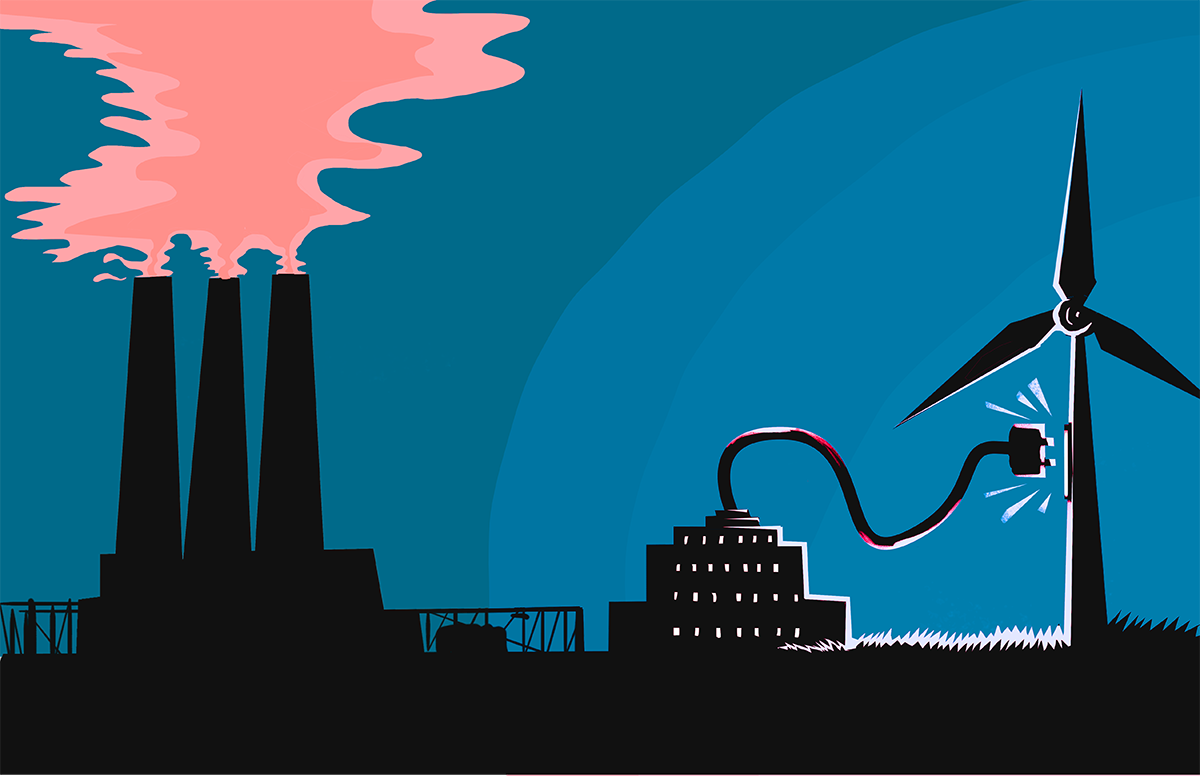
That cleaner energy sources are pushing coal out of the market is no longer news. Digging finite resources out of the ground is expensive, especially when one factors in environmental cleanup costs, and we’re becoming awfully good at harnessing abundant and free fuel courtesy of sun and wind. What is surprising, however, is how fast renewable energy adoption is happening on a regional scale. A massive power sharing network, private companies willing to build clean-energy projects at cutthroat rates, and improved battery storage are quickening the pace of wind and solar adoption in the West.
PacifiCorp, the largest grid operator in the West, embodies that accelerating transition. The Oregon-based utility today will submit its 20-year blueprint for how it expects to provide reliable electricity at the lowest cost to regulators in the six Western states where it operates. Draft documents and public presentations make clear that the power provider expects a major shift away from coal much sooner than the company signaled just a few years ago.
“The whole Western market is not favorable to coal. I think that’s the message from PacifiCorp and other utilities,” said David Schlissel, director of resource planning analysis at the Institute for Energy Economics and Financial Analysis.
PacifiCorp plans to retire 20 of its 24 coal-fired generating stations by 2038. In their place, the company expects to add more than 10,900 megawatts of wind and solar generation, plus another 2,800 megawatts of battery storage capacity to its grid. All said, the utility plans to retire nearly 4,500 megawatts of coal power by 2038. By comparison, the company’s 2015 plan projected taking only 2,800 megawatts of coal offline by 2034 (the company submits plans every two years).
PacifiCorp’s transition was presaged in late 2017, when Colorado utility Xcel Energy asked for renewable energy proposals to replace its aging coal plants. Xcel received a deluge of bids — more than 430 — at bottom-barrel prices.
“We were surprised, Xcel was surprised, analysts around the country were amazed and astounded at … how low the bid prices were,” Gwen Farnsworth, a senior policy energy advisor for Western Resource Advocates, told The Colorado Independent in 2018.
Wind generation already cost less than coal at the time, but the Xcel bids showed solar with battery storage also outcompeted about 75 percent of operating coal generation in Colorado.
“I think that was kind of a world-shaking experience for utilities,” Schlissel said.
Another factor fueling the clean energy shift is the ability for utilities to connect with that power when it’s needed. Since 2014, PacifiCorp — which serves customers in Utah, Wyoming, Idaho, Oregon, Washington, and California — has partnered with other utilities to create the Western Energy Imbalance Market, a transmission network that allows, for instance, coastal cities to access Wyoming wind power in the late afternoon as demand rises. Come 2022, 19 Western utilities will be part of the market.
As with many clean-energy breakthroughs, the shared grid has its roots in California.
“The California Independent System Operator, or CAISO, has been instrumental in developing the energy imbalance market,” Schlissel said. “They’re adding a huge amount of renewables, particularly solar. Those renewables will be available to other companies around the West.”
Sharing surplus renewable energy with other utilities has saved PacifiCorp’s 1.9 million ratepayers $200 million and removed 15 million tons’ worth of emissions since 2014, according to company information. By 2021, large utilities in every Western state except Colorado will be part of the grid market. The implication is clear: clean energy, in an increasing number of scenarios, is the most viable and affordable option for utilities.
“The economics of coal has changed. Other resources are more economically available,” PacifiCorp spokesperson Spencer Hall said. “The wind blows in Wyoming and the sun shines in Utah. There’s water in the Pacific Northwest. We put resource generation in places it makes sense.”
While retiring coal plants — which PacifiCorp estimates will save its customers $599 million — represents a decarbonization of the company’s energy portfolio, it doesn’t plan to eliminate fossil fuels entirely. The utility could add between 813 and 2,458 megawatts of new natural gas “peaking resources” that are deployed during high-demand periods. Some coal plants will stay online for decades, including Utah’s Hunter Plant.
Sarah Wright, executive director of Utah Clean Energy, called the utility’s 2019 plan a “big step in the right direction” but stressed that more needs to be done. For instance, she said, PacifiCorp isn’t adequately factoring in the external costs of its remaining fossil fuel operations, which will further contribute to climate change. Still, she expects utility plans to keep getting greener.
“Given that they update [plans] every two years, the economics of clean energy solutions will only continue to improve,” Wright said.
PacifiCorp’s plan, of course, has created major upset in some coal-dependent communities. The 2019 plan calls for the potential closure of units in three out of four of its Wyoming coal plants by 2028, for example — nearly a decade earlier, in some cases, than dates cited by the company in previous plans. In Kemmerer, Wyoming, that means the Naughton Plant’s coal units could close by 2025 instead of 2029.
“It was a shock to the community. Not only to the community, but to southwest Wyoming. A lot of people who work here live in Evanston or Bridger Valley, 50 miles from us,” said Kemmerer mayor Anthony Tomassi.
The news came just months after Westmoreland, which operates a coal mine outside Kemmerer, filed for bankruptcy. The mine and plant employ 400 in Kemmerer, according to Tomassi. “In a town of 3,200 people, that’s absolutely huge,” he said.
PacifiCorp also has big plans to construct transmission lines and wind assets in Wyoming — 3,500 megawatts by 2025 — but windmills don’t provide the long-term jobs or the high pay and benefits that come with a coal mine or the power plants they feed.
PacifiCorp representatives have committed to finding new jobs for Wyoming workers in the company, but those will likely be in other cities. “Some guys who are two or three years from retirement, do they want to move? I don’t know how that would play out,” Tomassi said.
Despite economic hurdles, Wyoming lawmakers are looking for solutions to save its coal communities. Governor Mark Gordon signed Senate File 159 into law this spring, which requires utilities to find new buyers for coal plants before they’re retired.
For Tomassi, it offers a glimmer of hope.
“From all indications there are groups of people who would be interested in buying that [Naughton] plant,” Tomassi said. “Our goal would be to see how long we can keep the plant running.”

